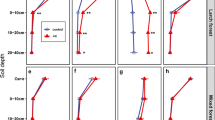Abstract
The skeletal fraction of forest soils in the Southern Black Forest has a cation exchange capacity (CEC) within the same order of magnitude as fine earth. As the base saturation in the skeleton is much higher than in the fine earth, stones provide a physiologically more favourable environment for nutrient uptake by plants. The fact that 70% of the skeleton grains showed adherent rhizomorphae and/or fine roots suggests that this potential is widely used by nutrient-adsorbing tissues. Therefore the ecological importance of this additional and, until now, unconsidered ion pool available to plants is probably higher than what is reflected by simple ion quantities. The effective CEC of the coarse fraction in forest sites with crystalline bedrock is reasonably predictable considering the water vapour adsorption of the 105°C dried skeleton at a suction of pF 4.6 (vapour pressure equilibrium with an oversaturated K2SO4 solution). The content of exchangeable base cations in the coarse fraction can be estimated using the content of exchangeable Mg in the fine earth. These stochastic relations are causally plausible. The regressions are a first approach to identify pedo-transfer functions predicting the skeleton’s nutrient potential with the aid of easily measurable site parameters.








Similar content being viewed by others
References
Brunauer S, Emmett P, Teller E (1958) Gases in multimolecular layers. J Amer Chem Soc 60:309–319
Buberl HG, von Wilpert K, Trefz-Malcher G, Hildebrand EE (1994) Der chemische Zustand von Waldböden in Baden-Württemberg. Mitt Forstl Versuchs Forschungsanstalt BW 182:1–99
Corti G, Ugolini F, Agnelli A, Certini G, Cuniglio R, Berna F, Fernandez M (2002) The soil skeleton, a forgotten pool of carbon and nitrogen in soil. Eur J Soil Sci 53:283–298
Deckers JA, Nachtergaele FO, Spaargaren OCC (1998) World reference base for soil ressources. International Society of Soil Science (ISSS), International Soil Reference and Information Centre (ISRIC) and Food and Agriculture Organization of the United Nations (FAO), Acco Leuven
Hildebrand EE (1994) The heterogeneous distribution of mobile ions in the rhizosphere of acid forest soils: facts, causes, and consequences. J Env Sci Health A29(9):1973–1992
Hildebrand EE, Schack-Kirchner H (2000) Initial effects of lime and rock powder application on soil solution chemistry in a Dystric Cambisol—results of model experiments. Nutrient Cycl Agroecosyst 56:69–78
Jongmans AG, van Breemen N, Lundström U, van Hees W, Finlay R, Srinivasan M, Unestam T, Giesler R, Melkerud P, Olsson M (1997) Rock eating fungi. Nature 389:682–683
Kohler M (2001) Ionenspeicher und Ionenmobilisierungspotentiale der Skelettfraktion von Waldböden im Schwarzwald. Freib Bodenk Abh 39:1–158
Kohler M, von Wilpert K, Hildebrand EE (2000) The soil skeleton as a source for the short term supply of “basic cations” in forest soils of the Black Forest. Water Air Soil Poll 122:37–48
McBratney AB, Minasny B, Cattle SR, Vervoort RW (2002) From pedotransfer functions to soil interference systems. Geoderma 109:41–73
Meiwes K-J, König N, Khanna PK, Prenzel J, Ulrich B (1984) Chemische Untersuchungsverfahren für Mineralböden, Auflagehumus und Wurzeln zur Charakterisierung und Bewertung der Versauerung in Waldböden. Ber Forschungszentr Waldökosyst Univ. Göttingen 7:1–67
Schack-Kirchner H, von Wilpert K, Hildebrand EE (2000) The spatial distribution of hyphae in structured soils. Plant Soil 224:195–205
Shaun A, Watmough P, Dillon J (2003) Mycorrhizal weathering in base-poor forests. Nature 423:823–824
Stahr K (1979) Die Bedeutung periglazialer Deckschichten für Bodenbildung und Standortseigenschaften im Südschwarzwald. Freib Bodenk Abh 9:1–273
Ugolini FC, Corti G, Agnelli A, Piccardi F (1996) Mineralogical, physical and chemical properties of rock fragments in soils. Soil Sci 161:521–542
Ugolini F, Corti G, Dufey JE, Agnelli A, Certini G (2001) Exchangeable Ca, Mg, and K of rock fragments and fine earth from sandstone and siltstone derived soils and their availability to grass. J Plant Nutr Soil Sci 164:309–315
van Breemen N, Lundström U, Jongmans AG (2000a) Do plants drive podsolization via rock-eating mycorrhizal fungi? Geoderma 94:163–171
van Breemen N, Finlay R, Lundström U, Jongmans AG, Giesler R, Olsson M (2000b) Mycorrhizal weathering: a true case of mineral plant nutrition? Biogeochemistry 49:53–67
von Wilpert K, Kohler M, Zirlewagen D (2000) To what extent can silviculture enhance sustainability of forest sites under the immission regime in Central Europe? Water Air Soil Poll 122:105–120
Zar JH (1999) Biostatistical analysis. Prentice Hall, Englewood Cliffs
Zirlewagen D (2002) Regionalisierung bodenchemischer Eigenschaften in topographisch stark gegliederten Waldlandschaften. PhD Dissertation, Universität Freiburg, Freiburg i. Br.
Acknowledgements
For financial support we thank the Federal Ministry of Education and Science. The project was involved in the program “Forward-Looking Forest Economy, Project Cooperation Southern Black Forest”.
Author information
Authors and Affiliations
Corresponding author
Rights and permissions
About this article
Cite this article
Heisner, U., Raber, B. & Hildebrand, E.E. The importance of the soil skeleton for plant-available nutrients in sites of the Southern Black Forest, Germany. Eur J Forest Res 123, 249–257 (2004). https://doi.org/10.1007/s10342-004-0041-7
Received:
Accepted:
Published:
Issue Date:
DOI: https://doi.org/10.1007/s10342-004-0041-7




